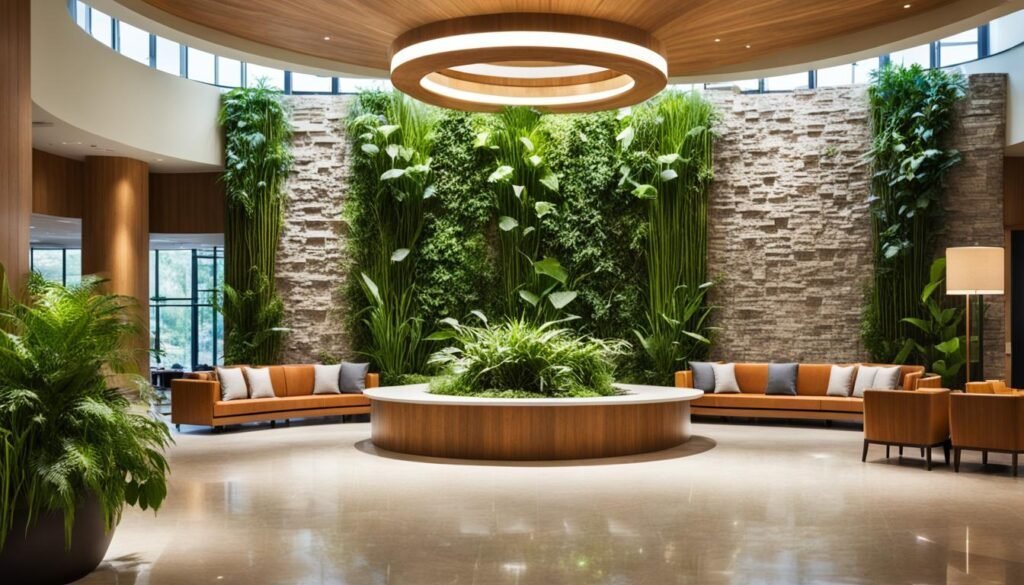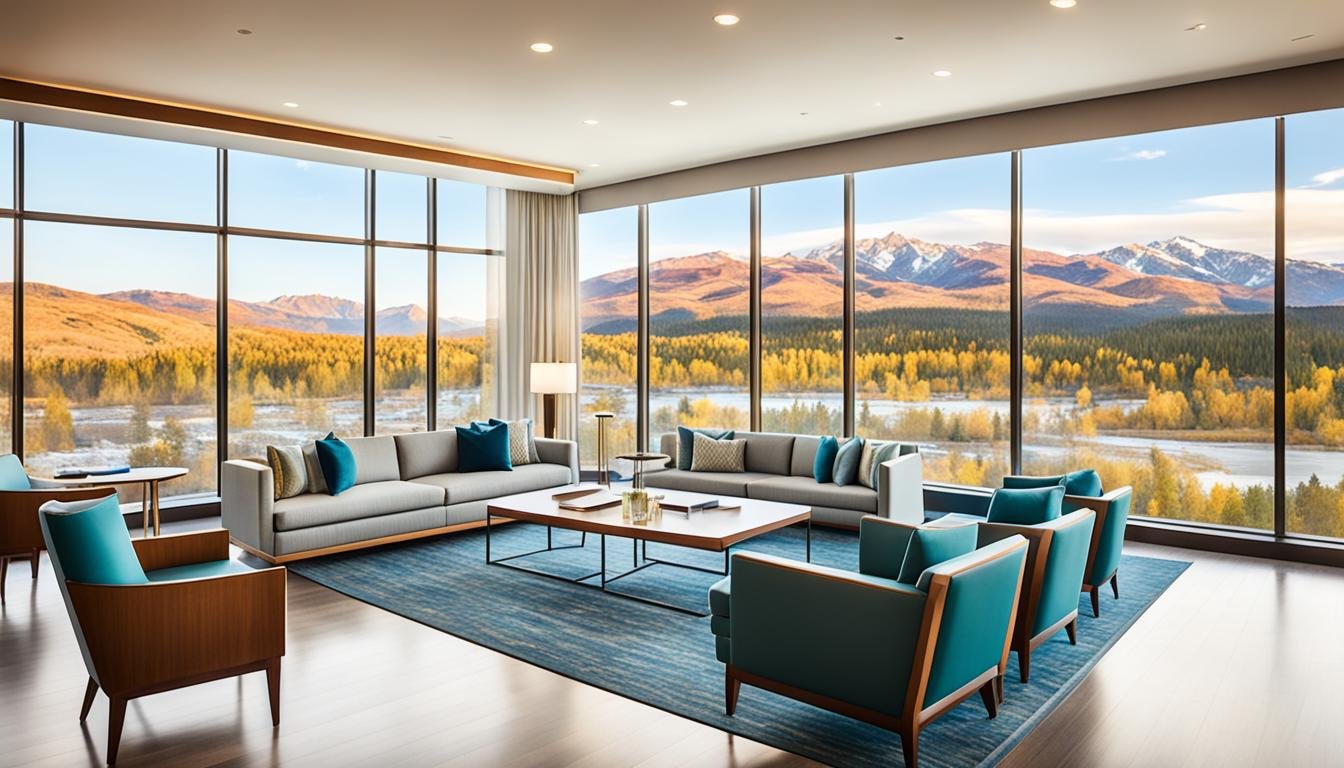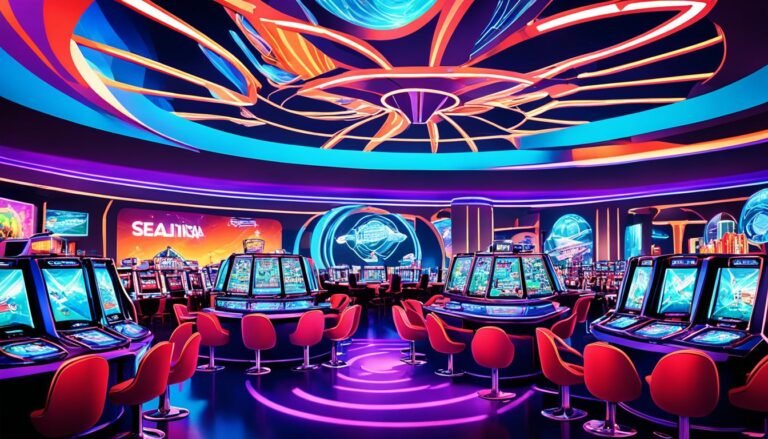Essentials of Hotel Design and Layout Explained
Welcome to the fascinating world of hotel design and layout. Every part matters, helping to create great memories for guests. From the lobby to the rooms they stay in, every choice in design is critical. These choices include the building’s overall look, how rooms are set up, the lighting, where the furniture goes, and adding natural elements.
Think about arriving at a hotel, tired from travel and looking for a cozy spot. The lobby greets you with soft lights that make it inviting. You hear gentle music, feel relaxed, and smell fresh flowers and coffee. You’ll see stylish furniture that’s not just nice to look at but perfect for friends to chat and relax together.
Walking to your room, you notice how smart the hotel’s layout is. There’s plenty of space, but it feels homey and not empty. The front desk is easy to find, a key spot for help and checking in. Plants, water features, and lots of natural light calm you, bringing nature into the hotel environment.
In your room, details show that a lot of thought went into making things right for you. Furniture is arranged so that you have space to use and rest. Everything you need is close by, making your stay both easy and pleasurable. The design creates a smooth feel and uses space well, ensuring you love your time there.
Designing hotels is an art form. Every choice enhances what guests feel and see. This goes for how the lobby is arranged, the furniture picked, and bringing nature indoors. Stick with us to learn more about these vital parts and how they shape an unforgettable hotel experience.
Key Takeaways:
- Hotel design and layout greatly influence the guest experience.
- Strategic lighting sets the mood and ambiance of the hotel lobby.
- An enhanced sensory experience engages guests through scent, music, and fresh coffee.
- Communal spaces foster a sense of community and convenience for guests.
- The right balance of open floor space creates a comfortable and visually appealing environment.
Strategic Lighting in Hotel Lobby Design
Lighting is crucial for making hotel lobbies warm and inviting. The right lighting can make a big difference in how guests feel. It enhances the look and feel of the space, leaving guests with a positive memory. When planning lighting, factors like bulb color, type of lights, and where they’re placed all matter.
The Importance of Color Temperature
The color temperature tells us if the light looks warm or cool. For hotel lobbies, warm light around 2700-3000 Kelvin is best. It makes the space feel welcoming and cozy, just like the sun at sunset. This type of light creates a soft, inviting atmosphere for visitors.
Choosing the Right Lighting Fixtures
Choosing the right light fixtures is key for a lobby’s style. Everything from ceiling lights to floor stands plays a part. It’s important to pick fixtures that match the look you want. Mixing different kinds of lights can make the lobby feel full and interesting.
“The strategic use of lighting fixtures can truly transform the ambiance of a hotel lobby. By carefully selecting and placing fixtures, we can create a captivating and memorable experience for our guests.”
There’s a line to walk between practical and beautiful lighting. Good lighting lets visitors see clearly and easily use the space. But it’s also about adding a touch of beauty and style with the right fixtures.
To make areas stand out, try spotlights or accent lights. These lights point out special parts of the room. They can highlight art, the building’s design, or other interesting features.
Getting help from lighting pros is a smart move. They know how to make the best use of your space. Their advice can help you create a lobby that feels just right.
In the end, lighting is key for a lobby that’s both welcoming and alluring. Think about the color of the light, the types of fixtures you use, and where they go. Doing this well can turn your lobby into a space guests will remember fondly.
| Benefits of Strategic Lighting in Hotel Lobbies | Examples of Lighting Fixtures |
|---|---|
|
|
Creating an Enhanced Sensory Experience in the Hotel Lobby
A well-designed hotel lobby does more than just look good. It grabs all five senses to leave a lasting memory on guests. We’ll look at several ways to up the sensory game in the lobby.
Scent Marketing
Scent marketing is incredibly effective. Picking the right smells can stir up certain feelings and make the place feel like home. Lighting candles or using fragrant diffusers sets a warm, welcoming mood.
Music Selection
The right music influences how we feel and what we think. A carefully crafted playlist of soft tunes can really add to the lobby’s vibe. It could be gentle classics, smooth jazz, or today’s hits. The aim is to relax and invite guests in.
Coffee Brewing
Nothing beats the smell of fresh coffee for starting the day right. Having a coffee spot in the lobby is not just about the drink. It’s about wakening taste buds and making noses happy too.
Offering Snacks
Having snacks out for guests is a nice plus. It gives them a chance to savor something tasty while taking in the lobby’s chic atmosphere. This includes everything from water with fruit all the way to tiny pastries.
Thinking about how the lobby feels and sounds helps hotels make a great first impression. Things like special scents, music, coffee, and snacks turn a regular visit into a top-notch experience.
The Importance of Communal Spaces in Hotel Design
Hotels now see the value in adding communal spaces to their designs. These are more than just lobbies. They let guests socialize, relax, or find places to be convenient. Areas like lounges, dining spaces, work spots, libraries, and outdoor spots make the stay better.
This kind of space is where people can meet and get to know each other. It makes everyone feel welcome and part of something. Travelers find something they like, no matter what they’re into.
“Communal spaces in hotels provide guests with the opportunity to connect with other travelers, exchange experiences, and build new relationships. They enrich the overall guest experience and contribute to a sense of belonging.” – Hotel Design Expert
Hotel lounges are perfect for relaxing or chatting with others. Dining areas are great for meals or quick snacks. They offer food for everyone, from simple choices to high-end meals.
For folks who work on the go, having a spot to work is key. Hotels offer these with fast internet, places to charge devices, and comfy seats. It keeps business travelers on track.
Libraries in hotels are quiet places to read, study, or think. They’re a quiet break from the busy scene. Guests can relax or just be by themselves for a bit.
Outdoor terraces are now a big hit in hotel design. They’re for getting fresh air and taking in the view. A terrace is a perfect place to relax, eat, or recharge after a day of adventures.
Hotels can use lobbies in smart ways to meet different needs. This not only makes guests happier. It also gives the hotel its own unique style and charm.
The Benefits of Communal Spaces in Hotel Design:
- Opportunities for social interaction and networking
- Enhanced guest experience and satisfaction
- Increase in guest loyalty and positive reviews
- Creation of a welcoming and community-oriented atmosphere
- Catering to the diverse needs and preferences of different types of travelers
- Maximization of space utilization and functionality
Finding the Right Balance of Open Floor Space in the Hotel Lobby
The hotel lobby’s design is crucial for making guests feel at ease and intrigued. It’s vital to get the amount of open space just right. This choice affects the lobby’s feel. The goal is to make guests feel both welcome and cozy.
Too little space in the lobby feels stifling, pushing guests away. Yet, too much space can feel cold and unwelcoming. Balancing this is key.
Hotel managers strive for a perfect balance, aiming to keep 10-15 percent of guests’ capacity open. This approach ensures guests can move freely without sacrificing a comfy, welcoming vibe.
The lobby should cater to its guests. A luxury destination might choose a snugger design. Here, less is more, with tiny nooks and plush seating. In comparison, a business-oriented spot might need more room. It allows professionals to meet and network easily.
Creating the lobby’s perfect mix is a complex but enriching task. It considers the number of guests, their needs, and the atmosphere wanted. Doing this right ensures a visually appealing and enjoyable space for all visitors.
| Benefits of Open Floor Space in the Hotel Lobby | Factors to Consider when Balancing Open Floor Space |
|---|---|
|
|
Finding the perfect balance for open space in the lobby is essential. It ensures a warm and interesting environment for each guest.
Choosing the Right Furniture for Hotel Lobby Layout
Furniture choice is key to making a hotel lobby look and feel right. The right furniture can turn the lobby into a warm, stylish spot. This sets a good vibe for everyone checking in.
Hotel lobby furniture includes items like coffee tables and chairs. These add more than just looks. They make the space cozy and inviting, too.
When picking out furniture, match the hotel’s style. Old furniture can make a historic hotel feel grand. For sleek places, modern designs work best.
Think about the area and who will stay at the hotel. A trendy spot might need modern furniture. But, if you’re after a classic feel, timeless pieces are better.
Don’t be afraid to mix old and new furniture. This can make the lobby unique and fun. Imagine modern sofas with vintage tables. It adds a cool mix to the space.
Furniture Styles in Hotel Lobby Design
| Historical Furniture | Modern Furniture | Contemporary Furniture |
|---|---|---|
|
– Classic designs with ornate detailing – Rich and luxurious materials like velvet and mahogany – Elaborate carvings and decorative motifs – Upholstered armchairs and chaise lounges |
– Clean lines and sleek profiles – Use of materials like metal, glass, and leather – Minimalist designs with a focus on functionality – Modular and space-saving furniture options |
– Cutting-edge designs with innovative shapes – Incorporation of unconventional materials and textures – Exploration of abstract and artistic concepts – Bold colors and striking patterns |
Choosing the right furniture helps make a lobby stand out. It can highlight the best features of the hotel. Whether using classic, modern, or bold pieces, the goal is to make the lobby a stylish, comfy place for all guests.
Incorporating Biophilic Elements in Hotel Lobby Design

Biophilic design means bringing nature inside our buildings. This creates a link between people and the natural world. In hotel lobbies, using natural elements like plants, light, water, and views can really change how guests feel.
Plants are especially important in biophilic design. They make the lobby look better and freshen the air. Mix tall trees with small plants for a varied, lovely look.
Natural light is key too. It makes the lobby feel welcoming and saves on electricity. Windows, skylights, and mirrors can flood the area with light, blurring the line between inside and out.
“Incorporating biophilic design elements immediately puts guests in a calmer and healthier mindset as soon as they enter the lobby.”
Adding a water feature can also transform the lobby. The sights and sounds of water relax us. Whether it’s a fountain or a small pond, it adds a peaceful touch.
Putting these natural elements in the lobby makes it a better place for guests. They’re not just nice to look at. They help people feel good and at home. By using plants, light, and water, biophilic design turns the lobby into a serene spot.
Designing the Front Desk for Functionality and Aesthetics
The front desk is the heart of a hotel lobby, welcoming guests. It’s where guests check in and out and get help. A good front desk design supports quick service and a smooth guest experience.
It’s vital to make the front desk both useful and beautiful. It needs to manage guest needs efficiently and look good. Its size and shape depend on how many guests you have and your lobby’s space.
The front desk must be highly functional. It should have all tools, like a computer and a phone, for check-ins. There should be plenty of storage to keep things organized but handy.
Adding special design touches makes the experience more memorable. Choose high-quality materials for a touch of elegance. You can also use the hotel’s logo to reinforce your brand.
Make sure everyone can reach the front desk easily. It needs to be accessible to people with disabilities. A dedicated spot for this, like a lower desk, can be a big help.
A well-planned front desk is the face of the hotel. It mixes practicality with beauty and access for all. This makes a great first impression on guests.
| Benefits of a Well-Designed Front Desk |
|---|
| Enhanced guest check-in/out experience |
| Efficient handling of guest inquiries and requests |
| Establishment of a strong brand identity |
| Improved accessibility for all guests |
| Contribution to the overall aesthetic of the hotel lobby |
Conclusion
Hotel design is key in making guests feel good. The lights, furniture, and layout all matter. They make the hotel work well and look inviting. Natural items, places to gather, and being close to nature can really make a hotel stand out. It makes guests happy and they remember their stay.
A hotel should feel comfy and look nice from the first step in. The design should offer space but still feel snug. Choosing the right furniture tells a story about the hotel. And the front desk is set up to be useful and quick. This helps guests have a fuss-free stay.
Well-planned design boosts the hotel’s vibe and how it works. It makes visitors feel at home and remember their time there. Attention to small things and smart designs can truly differentiate a hotel. It ensures guests have a great stay and come back again.







